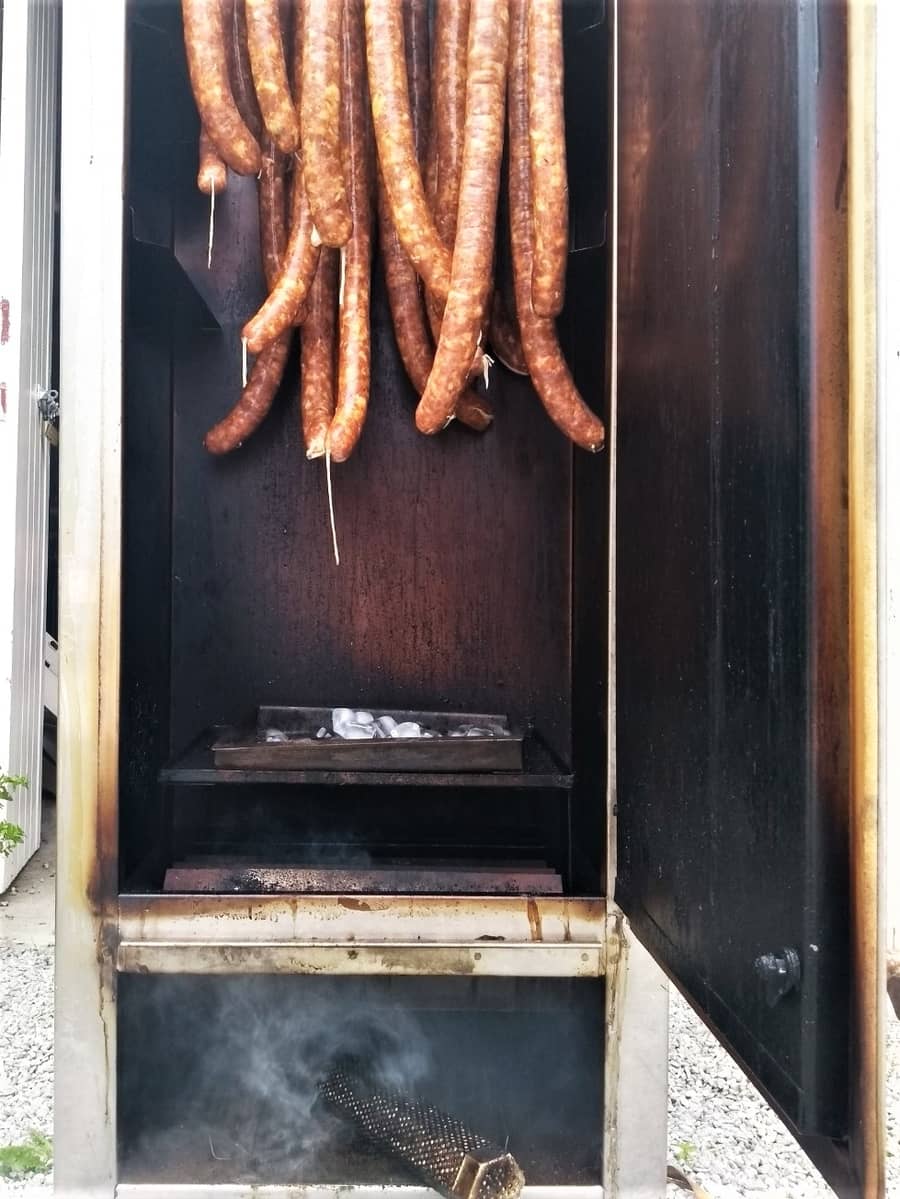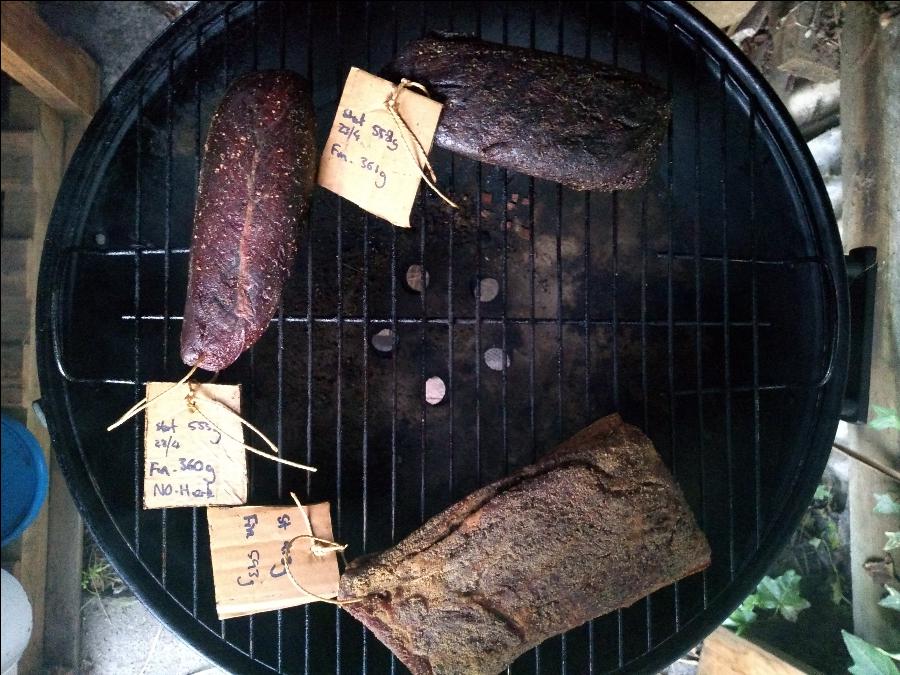Preserving meat and fish with smoke is a straightforward process. Cold smoking helps with preservation but isn’t the primary preserving effect; it is drying the meat and removing the moisture.
Summary:
Primary Preservation Method: Drying meat and removing moisture is the key to preservation, as it reduces water activity, which reduces the chance of unwanted bacterial growth.
Types of Smoking: Cold smoking can preserve meat when combined with salt curing, while warm and hot smoking primarily add flavor and cook the meat, not keeping it long-term (though it can be frozen).
Role of Salt: Salt curing, either through dry or wet methods, is essential for creating an inhospitable environment for bacteria, enhancing the preservation effects when combined with cold smoking.
Water activity, or the free movement of water inside the meat, is what unwanted bacteria look for to spoil meat. If moisture is removed from the meat or water movement activity is reduced, there is less chance of this type of bacteria, so meat can last longer and be more stable.
It has to be stated that smoking can come in many forms, such as cold, warm, and hot smoked. This relates directly to preservation since you must know what type of smoking applies and whether it preserves.
Another variable is whether the meat has been salt-cured either with wet or dry curing.
I have used every method; let’s clarify the different categories of smoking meat.
How Does Smoking Preserve Meat and Fish
Here is a table highlighting which method and whether it’s preserved for meat and fish:
| Smoking Method | Cured | Uncured |
|---|---|---|
| Cold Smoking | Preserved – months or years | Preserved |
| Warm Smoking | Short Term under 2-4 weeks | No |
| Hot Smoking | Short Term under 2 weeks | No |
Cold smoking methods are needed to preserve meat from smoke. This involves a salt cure to inhibit the bacteria; the cold-smoking phase is more about drying than smoking. Smoke carries antimicrobial and antifungal properties, keeping insects away from the meat during drying.
Warm and hot-smoking fish and meats are cooking methods with smoke for flavor; they are not preservation methods.
Cold Smoking Can Preserve Meat
Cold smoking is below 86°F or 30°C, ideally with high humidity and a little airflow (fish starts cooking above this temperature). This means cold smoking at nighttime when the dew level is higher, like about 70 or 80%.
There is another type of smoking, which is warm smoking, which is popular in central and eastern European countries, but in effect, this is still cooking the meat to an acceptable temperature it’s just done slowly and carefully.
I learned from a few decades of curing and cold-smoking meat that salt is very important.
What I find quite a lot is the confusion between smoking meat; I do all types of meat smoking.
In a primitive or survival situation, thinly sliced meat of fish or game meat can be dried with cold smoke around it to ward off bugs and pests while adding the protective factors the cold smoke has to the process.

Hot Smoking Does Not Preserve
There is hot smoking, or low and slow, which is direct heat with smoke in the cooking chamber. The other primary type of smoking is cold smoking; when I do this with meat, I always use proper salt curing either with the dry or wet brine salt water cure.
Warm Smoking Does Not Preserve Long Term
Warm smoking is a common term used in Eastern Europe. It’s a method of salt curing and then smoking meat at a temperature between the common cooking temperatures of below 100C/200F and above 30C/86F.
It’s considered a cooked, ready-to-eat style of cured meat.
Salt’s Importance for Preserving Meat
It depends on whether the smoked meat has been cured or not.
Salt creates an inhospitable environment for the bacteria that normally spoil meat; we’re not talking here about a little salt seasoning (like seasoning pork chops before grilling) when talking about more than that (seasoning is often about 0.5% salt to the weight of the meat or less. Salt Curing is 2.5-5%, traditional salt pork is 10%+).
The modern method that works if there is enough salt in the meat to preserve it is called the equilibrium curing method. By adding a percentage of salt to the meat’s weight, you choose how much salt will be added to the meat.
Before the equilibrium curing method came about, the saturation method of salt curing was used and still is. This means you saturate (also called the saturation method) the meat in a layer above and below it.
The smoke helps in a few different ways; however, it’s not the primary preserving effect.
Cold smoking, or smoke vapor, holds specific antimicrobial and antifungal properties. For thousands of years, it has been used to boost the effects of salted and dried meat.
By putting an extra layer of flavor and protection on the meat.
When I do my cold smoking and various types of projects, sometimes it’s just a smoldering bit of charcoal with some wood chips dropped on it. For some non-meat foods, you want a cooler environment. For me, 50-70°F or 10-20°C is what I like for meat, well under 86°F or 30°C, which is the definition of cold smoking (for instance, fish starts cooking above this temperature threshold).
So what happens to the meat is drying with smoke (vapor) flowing around it, as opposed to low and slow or hot smoking, which is cooking the meat with smoke flying around it (an oven with smoke is usually at a low temperature, but I also use indirect or direct hot smoking—portable smokers are good for quick fish hot smoking, for instance).
So, to summarize:
Ways of Smoking Meat, and How They Relate to Preserving
- Cold Smoking for flavor and preserving
- Hot Smoking/Low & Slow Smoking cooking and for flavor
- Warm Smoking for flavor cooking and for flavor
Here are a few examples of preserving (here is an article I wrote all about economical preserving) meat with cold smoking that I’ve done.


It is very common to see smoked bacon, and many people think that it will be preserved. But often, it is cooked until the internal temperature is safe; as soon as you start cooking meat, you are not preserving it.
Unless you cook it in fat, like a confit, then preserve it in a jar.
The fat doesn’t render, and to eat this type of ‘hot smoked’ bacon, you fry cook the bacon again.
There is a lot of misinformation out there when it comes to smoking and preserving; a lot of people haven’t got their head around the subject properly.
Marianski & Marianski wrote quite a few books on curing and salami – which serve as a guide for much of what I write; they are like textbooks about meat science.
Any smoker that heats up to 86°F or 30°C will not preserve the meat with the smoke. But don’t get me wrong—hot smoked bacon is still delicious!
So these smokers commonly barbecue only low and slow styles, if a pellet tube or smoke generator is added, they become cold smokers that could preserve meat, if the temperature/environment is conducive for this.
- Kettle smokers
- Drum smokers
- Offset smokers
- Pellet grill smokers
However, any of these could be used for cold smoking by using an outside smoldering smoke fire with the proper hardwood and piping smoke in.
Another alternative I use quite often is a pellet tube smoker, which smolders hardwood smoking pellets, and depending on how big the chamber is, I often use my 5 burner propane/gas grill; I smoke inside of it or an old kettle grill I have (putting the pellet tube underneath and closing up the area underneath so the smoke can drift up from the bottom vent.
Here is a post I did all about pellet tube smokers.

Tom Mueller
For decades, immersed in studying, working, learning, and teaching the craft of meat curing, sharing the passion and showcasing the world of charcuterie and smoked meat. Read More

I have mt. mahogany wood available for folks to smoke with. I sustainably harvest dead standing wood on property I own in Northeast CA. I have a building client base but want to expand my business. Any ideas?
Hey there, all I can say is an old Dutch butcher I use to hang out with, got leftover untreated mahogany wood from a furniture store for cold smoking many dry-cured meats. It was a darker/stronger smoke, but tasty!
Not sure of the mahogany variations across the world though!
Cheers
Tom